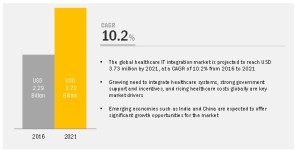Over the past decade, the global healthcare IT industry has witnessed technological transformation, right from the development of basic EMR/EMR solutions to specialized hospital information management systems, population health management solutions, and healthcare information exchange systems.
With the growing demand for simplified data sharing among various stakeholders in the healthcare industry, the majority of software vendors are focusing on ensuring interoperability in their product portfolio. Clinical healthcare IT solutions (such as EHR/EMR, CPOE, RIS, and CDSS) and non-clinical solutions (such as healthcare analytics and customer relationship management tools) are at the focus of such innovations from vendors in the healthcare IT market.
The global healthcare IT market is highly fragmented. A majority of small and mid-sized vendors have limited their presence to local or regional markets and are focused on developing specialized healthcare IT solutions. Cerner Corporation (U.S.), GE Healthcare (U.K.), Epic Systems, (U.S.), McKesson Corporation (U.S.), Philips N.V. (Netherlands), and Allscripts Healthcare Solutions, Inc. hold the highest shares in the clinical healthcare IT solutions market. Oracle Corporation (U.S.), Infor, Inc. (U.S.), SAP AG (Germany), and McKesson Corporation (U.S.) are the leaders in the non-clinical healthcare IT market.

Read More Details, Here | Download the PDF Brochure@ http://bit.ly/2BC5hb3
While product innovation remains at the center of the strategic growth initiatives pursued by the majority of key vendors, players are also focusing on increasing their presence in high-growth markets through expansion, marketing and distribution agreements, and acquisition. Currently, market players are focusing on expansion in the Asia-Pacific region.
Cerner Corporation’s leading position in the clinical solutions market is mainly attributed to its broad product portfolio and major focus on clinical healthcare IT solutions. While nearly 89% of the company’s revenue is generated from operations in the North American market, currently, the company is focusing on strengthening its presence in international markets as well. For instance, in February 2015, Cerner Corporation acquired Siemens’s health information technology business unit for ~USD 1.3 billion; this strengthened its client base in the global market and reach in European countries such as Germany, Austria, Spain, Sweden, and Norway.
McKesson Corporation offers a wide range of both clinical and non-clinical healthcare IT solutions; this has enabled the company to achieve a leading position in the global healthcare IT market. The company generates a majority of its revenue from North American operations. EPIC Systems (U.S.) and Allscripts Healthcare Solutions, Inc. are leading providers of EHR systems and related solutions in the U.S.
Other prominent players in the market include GE Healthcare (U.K.), Siemens Healthcare (Germany), and Philips Healthcare (Netherlands). These companies have strong global footprints, owing to their well-established sales and distribution networks. They also make significant investments in R&D activities to add innovative technologies and products to their portfolio. With their strong portfolios and efforts to develop innovative products, these companies are likely to maintain their leadership in the market in the coming years as well.
Still Searching for More Detailed information? | Feel Free to Talk to Our Research Experts, Here..!
Primary Research:
The healthcare IT solutions market comprises several stakeholders such as Healthcare IT solution providers healthcare IT vendors, healthcare IT service providers, healthcare payers, academic research institutes, government institutes, market research & consulting firms and venture capitalists & investors. Primary sources from the supply side include CEOs, vice presidents, marketing and sales directors, business development managers, and innovation directors of healthcare IT integration solutions companies. Demand-side primary sources include industry experts such as healthcare providers from hospitals and clinics and healthcare payers.
Secondary Research:
In the secondary research process, various secondary sources such as annual reports, press releases & investor presentations of companies, white papers, certified publications, articles by recognized authors, trade directories, and databases such as D&B Hoovers and Bloomberg Businessweek were referred to identify and collect information for this study.